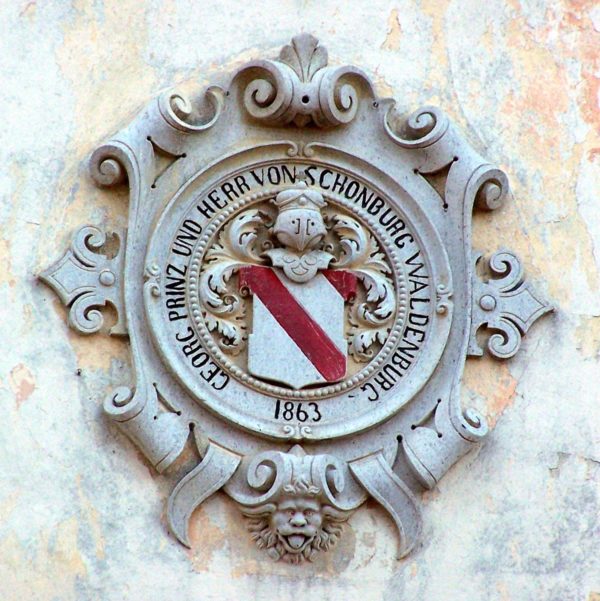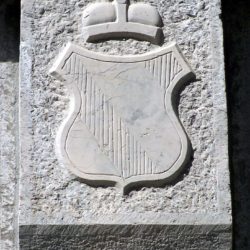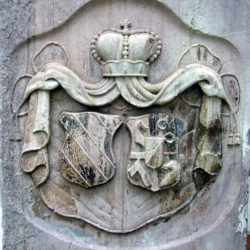
Coats of arms of the Princes Schönburg-Waldenburg in Snežnik Castle
KOZARIščE, SNEžNIK CASTLE
Location of the coat of arms: façade
“Schneeberg Castle [Sln. Snežnik] in Inner Carniola has recently been purchased for 499,600 silver florins by Prince von Schönburg-Waldenburg from Germany,” read a brief item featured in the newspaper Novice in 1853, signaling an end to the degradation of not only one of the oldest castles in Slovenia but also, and above all, the immense wealth of natural resources hidden in the vast forests of Snežnik. Having administered it poorly, its former owners, the Counts Lichtenberg, were forced to sell the Snežnik seigniory after holding it in possession for more than 150 years. The castle and its surroundings nevertheless remained abandoned and continued to decay for several years to come until a solution finally presented itself in 1853 through the Princes von Schönburg-Waldenburg.
The history of the Franco-Thuringian lineage of the Schönburg family dates back to the twelfth century, and their subsequent operations were primarily linked to the Electorate of Saxony, where, for centuries, they continued to acquire important estates that would give names to different family lines. By the eighteenth century, they had successfully introduced a special constitutional status for their territories and developed their own state structures. However, after 1740, they had to relinquish a large part of their independence to the benefit of Saxony. The family, elevated in its entirety to the rank of counts in 1700, had already in the sixteenth century split into the so-called upper (later princely) and lower (later comital) lines. In 1790, a member of the upper line, Otto Karl Friedrich (1758–1800), was raised to the rank of state prince, and his sons founded new lines—the elder, Otto Victor (1785–1859), founded the Schönburg-Waldenburg line and the younger, Heinrich Eduard (1787–1872), founded the Schönburg-Hartenstein line.
The most consequential for the history of Slovenia, and especially that of Snežnik Castle, was Prince Otto Victor’s family line. In 1853, Otto Victor purchased the deteriorated seigniory and bequeathed it to his third-born son Georg (1828–1900), who only learned about and took over his Inner Carniolan inheritance on his father’s death in 1859. In the desire to administer the neglected estate to the best of his abilities, he retired from the Austrian army and moved with his wife Luisa (née Princess von Bentheim-Tecklenburg, 1844–1922) to Snežnik for a while. There they first restored the decrepit castle building and then tended to its surroundings. Over the following decades and until the Second World War, Snežnik Castle experienced sound economic growth and became a popular destination for many of the prince’s relatives from high-ranking European nobility. Nonetheless, it did not serve as the Schönburgs’ permanent residence for long. Already in 1865, Prince Georg and his wife Luisa purchased Hermsdorf Castle near Dresden, where the family made its permanent residence while turning Snežnik into a summer residence, where they spent vacations and held hunting parties.
In the turbulent interwar years, the Schönburgs retained the Snežnik seigniory in its entirety, even though the Rapallo border ran through the center of their estate. The Yugoslav part was initially placed under state control, and the kingdom even temporarily dispossessed Prince Hermann on grounds of his German nationality. Nonetheless, he managed to regain possession of the entire estate in 1924. He also had a lucky hand with the stewards of the castle—Heinrich Schollmayer-Lichtenberg and after him Leon Schauta, who protected the castle from looting and arson during the Second World War and thus ensured that the building, along with its small inventory, awaited the creation of the postwar Yugoslav state largely intact.
After the war, Snežnik Castle was nationalized and converted into a museum. Although the Schönburgs never returned, their memory is still kept alive by many material objects, including their coat of arms, displayed in various locations—above the castle entrance, on the fireplace in the entrance hall, on the small inventory (glasses), and on the so-called zero mile stone in the castle park, which was once used to measure the lengths of roads in the Snežnik seigniory. A colored variant of the Schönburg coat of arms may also be seen on the wall of the castle outbuilding, encircled by the inscription GEORG PRINZ UND HERR VON SCHONBURG WALDENBURG 1863.
Sources:
Genealogisches Handbuch des Adels, 114, pp. 390–391.
Kačičnik Gabrič, Alenka, O kmečkih dolgovih nekoliko drugače. Ljubljana, 2004.
Slana, Lidija: Iz zgodovine gradu in gospostva Snežnik na Notranjskem. Kronika, 48, 2000, nos. 1–2 (Iz zgodovine snežniške graščine), pp. 20–41.


